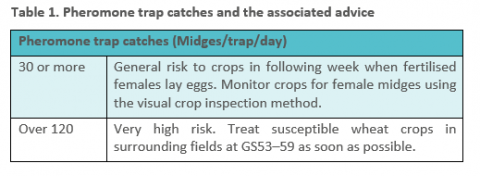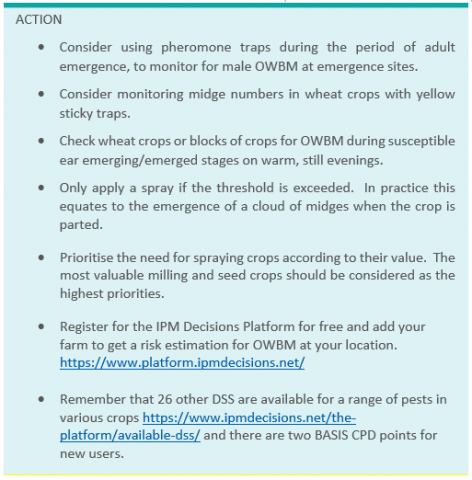Steve Ellis
Temperatures for the period 15th to 21st May were above the long-term average and rainfall was also below average. As a result, the Rothamsted Insect Survey (RIS) report that cereal aphid flight activity has continued to increase by about 130%. First flights were recorded for rose-grain aphid from Newcastle (Tyne & Wear) and grain aphid from York (North Yorkshire).
Aphids continue to be reported in crops but as yet we have not been told that the threshold has been exceeded. As ears start to emerge, we are approaching the stage at which the threshold changes. Full details of cereal aphid thresholds are given below:
- · Before GS61 – 50% of tillers infested
- GS61 to two weeks before the end of grain filling – 66% of tillers are infested and numbers are increasing
Also look out for parasitism and predation by natural enemies before deciding to revert to insecticides.
Full details of all trap catches are available here.

From the 15th to 21st May orange wheat blossom midge (OWBM) were again caught at all RIS trap locations. The IPM Decisions Platform is now indicating high risk status for OWBM at most ADAS sites meaning conditions are currently suitable for emergence and migration into crops is likely.
High risk dates in the risk status chart (Figure 3) indicate predicted dates of emergence and multiple emergence dates are possible. Our best advice is to monitor susceptible crops throughout the susceptible period (GS53-59) for adult female midges during the evenings. Emergence of male midges can also be monitored at emergence sites using pheromone traps. OWBM-susceptible varieties of winter wheat crops are at risk until the early flowering stages are reached (average GS61, including secondary tillers across the field).
Crop monitoring for OWBM
A critical factor will be whether the susceptible growth stages coincide with the egg-laying activity of female midges. Logistically, it is impractical to monitor large areas of wheat potentially at risk in the limited time available. It helps if blocks of wheat crops can be monitored rather than many individual fields when midges start to emerge. Checking will enable higher-risk fields that may benefit from treatment to be identified. Group 1 and 2 wheats, and seed crops, should be made priorities for monitoring and need for OWBM control.
Pheromone traps
The pheromone lures attract male midges to the trap as soon as they emerge from pupae in the soil. The appearance of males in pheromone traps is an indicator that crops should now be monitored for egg laying females. The pheromone traps will provide an early indication of midge emergence and enable susceptible crops of wheat to be assessed for midges either visually or by using sticky traps. If catches are very high, then a decision on whether to spray can be based on the trap catches. Thresholds are given in Table 1 below.

If threshold catches of midges in pheromone traps (or other local warnings) indicate a general risk, check non-resistant varieties of winter wheat during susceptible ear emerging/emerged stages (GS 51-59). It is suggested that you give the highest priority to crops at mid- to late ear emergence, stages GS 53-59.
Yellow sticky traps
Crops can be monitored using two yellow sticky traps placed at ear height in susceptible varieties of winter wheat during the risk period. An approximate threshold for yellow sticky traps is reached if ten or more midges are caught per trap during the period that crops are at susceptible ear emerging/emerged stages and before the bulk of a crop is flowering (average GS 61 including secondary tillers).
In-field monitoring
This is usually best done from mid-evening when the midges are more evenly spread. Part the crop and count the number of midges. A control threshold is reached in susceptible milling and seed varieties of wheat if an average of one midge per six ears is found. For susceptible feed wheat varieties, the threshold is an average of one midge per three ears. In practice it is very difficult to assess midge numbers per ear, so if you part the crop and a cloud of midges appears, this can be considered a threshold.
Control with insecticides
Lambda-cyhalothrin, a pyrethroid, can be used to control OWBM. Timing is crucial as treatments kill only the adults present at the time of spraying.
It is important to follow label recommendations.
Further information on this sporadic pest is available in AHDB Information Sheet 53 on guidelines for monitoring and control of orange wheat blossom midge.


